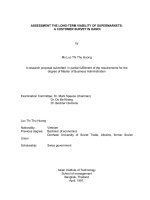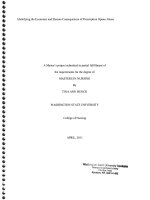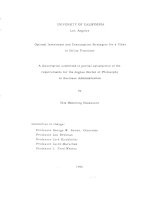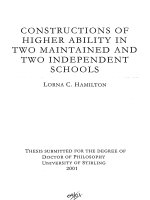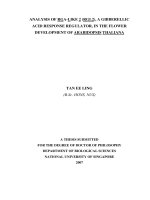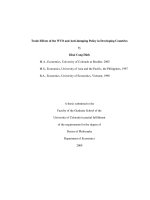Submitted For The Award Of The Degree Of Doctor Of Philosophy In Management
Bạn đang xem bản rút gọn của tài liệu. Xem và tải ngay bản đầy đủ của tài liệu tại đây (460.96 KB, 153 trang )
A STUDY OF FDI AND INDIAN ECONOMY
Submitted for the award of the degree of
Doctor of Philosophy
In
Management
By
Ms. SAPNA HOODA
Registration No: 2K07-NITK-Ph.D1169-HU
Under the supervision of
DR. RAJENDER KUMAR
(Professor)
DEPARTMENT OF HUMANITIES AND SOCIAL SCIENCES
NATIONAL INSTITUTE OF TECHNOLOGY
(DEEMED UNIVERSITY)
KURUKSHETRA – 136119
HARYANA
(JANUARY 2011)
NATIONAL INSTITUTE OF TECHNOLOGY, KURUKSHETRA,
DEEMED UNIVERSITY, KURUKSHETRA, HARYANA, INDIA.
CERTIFICATE
This is to certify that the thesis entitled, “A STUDY OF FDI AND INDIAN
ECONOMY”, being submitted by SAPNA HOODA to the National
Institute of Technology, Kurukshetra, Deemed University, Kurukshetra, for
the award of the degree of Doctor of Philosophy is a record of bonafide
research work carried out by her.
The matter presented in this thesis has not been submitted for the award of
any other degree of this or any other institute.
(Ms. SAPNA HOODA)
Candidate
This is to certify that the above statement made by the candidate is correct to
the best of my knowledge.
Date: ……………….
DR. RAJENDER KUMAR
(Professor)
Department of Humanities and Social Sciences,
NIT, Kurukshetra, Haryana, India.
ACKNOWLEDGEMENT
I sincerely express my deep sense of gratitude to Dr. RAJENDER
KUMAR, (Professor), Deptt. of Humanities and Social Sciences, National
Institute of Technology, Kurukshtra, for his extraordinary cooperation, invaluable
guidance and supervision. This thesis is the result of his painstaking and generous
attitude.
I would like to thank the members of Board of Studies, N.I.T.,
Kurukshetra for their valuable suggestions and useful comments throughout this
research work.
I owe and respectfully offer my thanks to my noble parents for their
constant moral support and mellifluous affection which helped me to achieve
success in every sphere of life and without their kind devotion this thesis would
have been a sheer dream.
I am also thankful to my siblings for their constructive discussions,
perseverance and encouragement during this research work.
I would also extend my special thanks to my Jiju and nephews of mine for
their humour and light-heartedness during this time consuming effort of mine.
I sincerely acknowledge the efforts of all those who have directly or
indirectly helped me in completing my thesis successfully.
It is the kindness of these acknowledged persons that this thesis sees the
light of the day.
I submit this thesis of mine with great humility and utmost regard.
(Ms. SAPNA HOODA)
Regn. No.2K07-NITK-Ph.D1169-HU
CONTENTS
¾ Chapter-1
Page No.
1.0 Introduction
1
1.1 An Overall View
1
1.2 FDI Inflows in India in Post Reform Era
6
1.3 Objectives
8
1.4 Hypotheses
8
1.5 Research Methodology
8
1.6 Importance of the study
11
1.7 Limitations of the study
12
¾ Chapter-2 REVIEW OF LITERATURE
2.0 Introduction
14
2.1 Temporal Studies
14
2.2 Inter – Country Studies
20
2.3 Inter – Industry Studies
36
2.4 Studies in Indian Context
38
2.5 Conclusions
42
2.6 Research issues and Research Gaps
44
¾ Chapter-3 TRENDS AND PATTERNS OF FDI INFLOWS
3.0 Introduction
46
3.1 Trends and Patterns of FDI in the World
47
3.2 Trends and Patterns of FDI flow in Asia
51
3.3 Trends and Patterns of FDI flow in India
54
3.4 Sources of FDI in India
60
3.5 Distribution of FDI within India
62
3.6 Trends and Patterns of FDI flow at Sectoral level
63
3.7 International Investment Agreements
76
3.8 Conclusions
76
¾ Chapter-4 FDI AND INDIAN ECONOMY
4.0 Introduction
83
4.1 FDI and Indian Economy
84
4.2 Selection of Variables
84
4.3 Role of FDI on Economic Growth
108
4.4 Conclusions
114
¾ Chapter-5 FINDINGS AND SUGGESTIONS
116
BIBLIOGRAPHY
131
LIST OF TABLES
vi
LIST OF CHARTS
vii
LIST OF TABLES
Table No.
Title
Page No.
Table 1.1:
FDI inflows in India (from 1948 - 2010)
4
Table 3.1:
FDI flows in the World (from 1991-2007)
47
Table 3.2:
Share of India in World FDI
49
Table 3.3:
Emerging economies in the World
50
Table 3.4:
Emerging economies of Asia
51
Table 3.5
Doing Business Indicators
52
Table 3.6:
Major Sources of FDI in India
60
Table 4.1:
FDI Flow in India (from 91-92 to 07-08)
87
Table 4.2
GDPFC of India (from 91-92 to 08-09)
89
Table 4.3:
Total Trade of India (from 91-92 to 08-09)
93
Table 4.4:
Foreign Exchange Reserves of India
(from 91-92 to 08-09)
96
Table 4.5:
R &D expenditure of India (from 91-92 to 08-09)
99
Table 4.6:
Financial Position of India (from 91-92 to 08-09)
101
Table 4.6.1: International Comparison of Top 10
Debtor Countries, 2007
102
Table 4.6.2: Debt service ratio and ratio of foreign
exchange to debt
Table 4.7:
103
Exchange Rates of India
(from 91-92 to 08-09)
105
Table 4.8:
Foreign Direct Investment Model
109
Table 4.9:
Predicted Signs of Explanatory Variables
110
Table 4.10:
Economic Growth Model
113
LIST OF CHARTS
Title
Chart No.
Chart-1.1:
FDI inflows in India (from 1948-2010)
Chart-1.2:
FDI inflows (from Developed, Developing
Page No.
5
Nations and NRI Investments in India)
7
Chart-1.3:
FDI inflows in India (from 1991-2008)
7
Chart-3.1:
Share of developed and developing
economies in world FDI
48
Chart-3.2:
India’s share in World FDI
49
Chart-3.3:
Most attractive location of global FDI
50
Chart-3.4:
Major Asian economies
52
Chart-3.5:
Trends in FDI inflows at Indian level
55
Chart-3.6:
Trends in Route – wise FDI equity inflows
in India
56
Chart-3.7:
Approved and Actual FDI inflows
57
Chart-3.8:
Actual FDI inflows as a percentage of
approved FDI
58
Chart-3.9:
Types of FDI inflows
58
Chart-3.10:
Sector – wise distribution of FDI inflows
59
Chart-3.11:
Share of top countries in FDI inflows
61
Chart- 3.12: Distribution of FDI within India
62
Chart- 3.13: Trends in Infrastructure Sector
64
Chart- 3.14: Trends in Services Sector
65
Chart- 3.15: Trends in Trading Sector
67
Chart- 3.16: Trends in Consultancy Sector
68
Chart- 3.17: Trends in Education Sector
69
Chart- 3.18: Trends in Housing and Real Estate Sector
70
Chart- 3.19: Trends in Construction Activities Sector
71
Chart- 3.20: Trends in Automobile Industry
73
Chart- 3.21: Trends in Computer Software and
Hardware Sector
Chart- 3.22: Trends in Telecommunications Sector
Chart- 4.1:
74
75
Movement of FDI inflows in India
(from 91-92 to 07-08)
88
Chart- 4.2:
GDPFC of India (from 91-92 to 08-09)
90
Chart- 4.3:
TradeGDP (Trade as percentage of GDP)
92
Chart- 4.4:
Foreign Exchange Reserves as
percentage of GDP
95
Chart- 4.5:
R&D expenditure as percentage of GDP
98
Chart- 4.6:
Financial Position (ratio of debt to
exports of India)
100
Chart- 4.6.1: Concessional and Short – Term
Chart- 4.7:
Debt as % of Total Debt
104
Movement in Exchange Rates of India
106
CHAPTER – 1
1.0 INTRODUCTION
One of the most striking developments during the last two decades is the spectacular
growth of FDI in the global economic landscape. This unprecedented growth of global
FDI in 1990 around the world make FDI an important and vital component of
development strategy in both developed and developing nations and policies are designed
in order to stimulate inward flows. Infact, FDI provides a win – win situation to the host
and the home countries. Both countries are directly interested in inviting FDI, because
they benefit a lot from such type of investment. The ‘home’ countries want to take the
advantage of the vast markets opened by industrial growth. On the other hand the ‘host’
countries want to acquire technological and managerial skills and supplement domestic
savings and foreign exchange. Moreover, the paucity of all types of resources viz.
financial, capital, entrepreneurship, technological know- how, skills and practices, access
to markets- abroad- in their economic development, developing nations accepted FDI as a
sole visible panacea for all their scarcities. Further, the integration of global financial
markets paves ways to this explosive growth of FDI around the globe.
1.1 AN OVERALL VIEW
The historical background of FDI in India can be traced back with the establishment of
East India Company of Britain. British capital came to India during the colonial era of
Britain in India. However, researchers could not portray the complete history of FDI
pouring in India due to lack of abundant and authentic data. Before independence major
amount of FDI came from the British companies. British companies setup their units in
mining sector and in those sectors that suits their own economic and business interest.
After Second World War, Japanese companies entered Indian market and enhanced their
trade with India, yet U.K. remained the most dominant investor in India.
Further, after Independence issues relating to foreign capital, operations of MNCs, gained
attention of the policy makers. Keeping in mind the national interests the policy makers
designed the FDI policy which aims FDI as a medium for acquiring advanced technology
and to mobilize foreign exchange resources. The first Prime Minister of India considered
foreign investment as “necessary” not only to supplement domestic capital but also to
secure scientific, technical, and industrial knowledge and capital equipments. With time
and as per economic and political regimes there have been changes in the FDI policy too.
The industrial policy of 1965, allowed MNCs to venture through technical collaboration
in India. However, the country faced two severe crisis in the form of foreign exchange
and financial resource mobilization during the second five year plan (1956 -61).
Therefore, the government adopted a liberal attitude by allowing more frequent equity
participation to foreign enterprises, and to accept equity capital in technical
collaborations. The government also provides many incentives such as tax concessions,
simplification of licensing procedures and de- reserving some industries such as drugs,
aluminium, heavy electrical equipments, fertilizers, etc in order to further boost the FDI
inflows in the country. This liberal attitude of government towards foreign capital lures
investors from other advanced countries like USA, Japan, and Germany, etc. But due to
significant outflow of foreign reserves in the form of remittances of dividends, profits,
royalties etc, the government has to adopt stringent foreign policy in 1970s. During this
period the government adopted a selective and highly restrictive foreign policy as far as
foreign capital, type of FDI and ownerships of foreign companies was concerned.
Government setup Foreign Investment Board and enacted Foreign Exchange Regulation
Act in order to regulate flow of foreign capital and FDI flow to India. The soaring oil
prices continued low exports and deterioration in Balance of Payment position during
1980s forced the government to make necessary changes in the foreign policy. It is
during this period the government encourages FDI, allow MNCs to operate in India.
Thus, resulting in the partial liberalization of Indian Economy. The government
introduces reforms in the industrial sector, aimed at increasing competency, efficiency
and growth in industry through a stable, pragmatic and non-discriminatory policy for FDI
flow.
Infact, in the early nineties, Indian economy faced severe Balance of payment
crisis. Exports began to experience serious difficulties. There was a marked increase in
petroleum prices because of the gulf war. The crippling external debts were debilitating
the economy. India was left with that much amount of foreign exchange reserves which
can finance its three weeks of imports. The outflowing of foreign currency which was
deposited by the Indian NRI’s gave a further jolt to Indian economy. The overall Balance
of Payment reached at Rs.( -) 4471 crores. Inflation reached at its highest level of 13%.
Foreign reserves of the country stood at Rs.11416 crores. The continued political
uncertainty in the country during this period adds further to worsen the situation. As a
result, India’s credit rating fell in the international market for both short- term and long-
term borrowing. All these developments put the economy at that time on the verge of
default in respect of external payments liability. In this critical face of Indian economy
the then finance Minister of India Dr. Manmohan Singh with the help of World Bank and
IMF introduced the macro – economic stabilization and structural adjustment programm.
As a result of these reforms India open its door to FDI inflows and adopted a more liberal
foreign policy in order to restore the confidence of foreign investors.
Further, under the new foreign investment policy Government of India constituted
FIPB (Foreign Investment Promotion Board) whose main function was to invite and
facilitate foreign investment through single window system from the Prime Minister’s
Office. The foreign equity cap was raised to 51 percent for the existing companies.
Government had allowed the use of foreign brand names for domestically produced
products which was restricted earlier. India also became the member of MIGA
(Multilateral Investment Guarantee Agency) for protection of foreign investments.
Government lifted restrictions on the operations of MNCs by revising the FERA Act
1973. New sectors such as mining, banking, telecommunications, highway construction
and management were open to foreign investors as well as to private sector.
Table-1.1
FDI INFLOWS IN INDIA
(from 1948-2010)
Amount
of FDI
In
crores
Mid
1948
256
March
1964
565.5
March
1974
916
March
1980
933.2
March
1990
2705
Source: Kumar39 1995, various issues of SIA Publication.
March
2000
18486
March
2010
1,23,378
There is a considerable decrease in the tariff rates on various importable goods.
Table –1.1 shows FDI inflows in India from 1948 – 2010.FDI inflows during 1991-92 to
March 2010 in India increased manifold as compared to during mid 1948 to march 1990
(Chart-1.1). The measures introduced by the government to liberalize provisions relating
to FDI in 1991 lure investors from every corner of the world. There were just few (U.K,
USA, Japan, Germany, etc.) major countries investing in India during the period mid
1948 to march 1990 and this number has increased to fifteen in 1991. India emerged as a
strong economic player on the global front after its first generation of economic reforms.
As a result of this, the list of investing countries to India reached to maximum number of
120 in 2008. Although, India is receiving FDI inflows from a number of sources but large
percentage of FDI inflows is vested with few major countries. Mauritius, USA, UK,
Japan, Singapore, Netherlands constitute 66 percent of the entire FDI inflows to India.
FDI inflows are welcomed in 63 sectors in 2008 as compared to 16 sectors in 1991.
Chart – 1.1
FDI Flow in India
(1948-2010)
Amt. in Rs.
crores
140000
120000
100000
80000
60000
40000
20000
0
March
1948
March
1964
March
1974
March
1980
March
1990
Years
Source: Kumar 1995, various issues of SIA Publication.
March
2000
March
2010
amt. in crores
The FDI inflows in India during mid 1948 were Rs, 256 crores. It is almost double in
March 1964 and increases further to Rs. 916 crores. India received a cumulative FDI
inflow of Rs. 5,384.7 crores during mid 1948 to march 1990 as compared to Rs.1,41,864
crores during August 1991 to march 2010 (Table-1.1). It is observed from the (Chart –
1.1) that there has been a steady flow of FDI in India after its independence. But there is a
sharp rise in FDI inflows from 1998 onwards. U.K. the prominent investor during the pre
and post independent era stands nowhere today as it holds a share of 6.1 percent of the
total FDI inflows to India.
1.2 FDI INFLOWS IN INDIA IN POST REFORM ERA
India’s economic reforms way back in 1991 has generated strong interest in
foreign investors and turning India into one of the favourite destinations for global FDI
flows. According to A.T. Kearney1, India ranks second in the World in terms of
attractiveness for FDI. A.T. Kearney’s 2007 Global Services Locations Index ranks India
as the most preferred destination in terms of financial attractiveness, people and skills
availability and business environment. Similarly, UNCTAD’s76 World Investment
Report, 2005 considers India the 2nd most attractive destination among the TNCS. The
positive perceptions among investors as a result of strong economic fundamentals driven
by 18 years of reforms have helped FDI inflows grow significantly in India. The FDI
inflows grow at about 20 times since the opening up of the economy to foreign
investment. India received maximum amount of FDI from developing economies (Chart
– 1.2). Net FDI flow in India was valued at US$ 33029.32 million in 2008. It is found
that there is a huge gap in FDI approved and FDI realized (Chart- 1.3). It is observed that
the realization of approved FDI into actual disbursements has been quite slow. The
reason of this slow realization may be the nature and type of investment projects
involved. Beside this increased FDI has stimulated both exports and imports, contributing
to rising levels of international trade. India’s merchandise trade turnover increased from
US$ 95 bn in FY02 to US$391 bn in FY08 (CAGR of 27.8%).
Chart-1.2
FDI INFLOWS IN INDIA
US$ millions
60000
50000
40000
30000
20000
10000
0
Developed Countries
Developing Countries
NRI's
1991-2008
Source: compiled and computed from the various issues of SIA Bulletin, Ministry of
Commerce, GOI
Chart-1.3
FDI INFLOWS IN INDIA
US$Millions
1991-2008
40000
30000
20000
10000
0
'91
93
95
97
99
01
03
05
07
YEARS
amount of FDI realised
amount of FDI approved
No. of FDI approved
realised to approved ratio
Source: compiled and computed from the various issues SIA Bulletin, Ministry of
Commerce, GOI
India’s exports increased from US$ 44 bn in FY02 to US$ 163 bn in FY08 (CAGR of
24.5%). India’s imports increased from US$ 51 bn in FY02 to US$ 251 bn in FY08
(CAGR of 30.3%). India ranked at 26th in world merchandise exports in 2007 with a
share of 1.04 percent.
Further, the explosive growth of FDI gives opportunities to Indian industry for
technological upgradation, gaining access to global managerial skills and practices,
optimizing utilization of human and natural resources and competing internationally with
higher efficiency. Most importantly FDI is central for India’s integration into global
production chains which involves production by MNCs spread across locations all over
the world. (Economic Survey 2003-04).16
1.3 OBJECTIVES
The study covers the following objectives:
1. To study the trends and patterns of flow of FDI.
2. To assess the determinants of FDI inflows.
3. To evaluate the impact of FDI on the Economy.
1.4 HYPOTHESES
The study has been taken up for the period 1991-2008 with the following hypotheses:
1. Flow of FDI shows a positive trend over the period 1991-2008.
2. FDI has a positive impact on economic growth of the country.
1.5 RESEARCH METHODOLOGY
1.5.1 DATA COLLECTION
This study is based on secondary data. The required data have been collected from
various sources i.e. World Investment Reports, Asian Development Bank’s Reports,
various Bulletins of Reserve Bank of India, publications from Ministry of Commerce,
Govt. of India, Economic and Social Survey of Asia and the Pacific, United Nations,
Asian Development Outlook, Country Reports on Economic Policy and Trade PracticeBureau of Economic and Business Affairs, U.S. Department of State and from websites
of World Bank, IMF, WTO, RBI, UNCTAD, EXIM Bank etc.. It is a time series data and
the relevant data have been collected for the period 1991 to 2008.
1.5.2
ANALYTICAL TOOLS
In order to analyse the collected data the following mathematical tools were
used. To work out the trend analyses the following formula is used:
a.) Trend Analysis i.e. ŷ = a + b x
where ŷ = predicted value of the dependent variable
a = y – axis intercept,
b = slope of the regression line (or the rate of change in y for a given
change in x),
x = independent variable (which is time in this case).
b.) Annual Growth rate is worked out by using the following formula:
AGR = (X2- X1)/ X1
where X1 = first value of variable X
X2 = second value of variable X
c.) Compound Annual Growth Rate is worked out by using the following
formula:
CAGR (t0, tn) = (V(tn)/V(t0))1/tn – t0 -1
where
V (t0): start value, V (tn): finish value, tn − t0: number of years.
In order to analyse the collected data, various statistical and mathematical
tools were used.
1.5.3
MODEL BUILDING
Further, to study the impact of foreign direct investment on economic growth, two
models were framed and fitted. The foreign direct investment model shows the factors
influencing the foreign direct investment in India. The economic growth model depicts
the contribution of foreign direct investment to economic growth. The two model
equations are expressed below:
1
FDI = f [TRADEGDP, RESGDP, R&DGDP, FIN. Position, EXR.]
2
GDPG = f [FDIG]
where,
FDI= Foreign Direct Investment
GDP = Gross Domestic Product
FIN. Position = Financial Position
TRADEGDP= Total Trade as percentage of GDP.
RESGDP= Foreign Exchange Reserves as percentage of GDP.
R&DGDP= Research & development expenditure as percentage of GDP.
FIN. Position = Ratio of external debts to exports
EXR= Exchange rate
GDPG = level of Economic Growth
FDIG = Foreign Direct Investment Growth
Regression analysis (Simple & Multiple Regression) was carried out using
relevant econometric techniques. Simple regression method was used to measure the
impact of FDI flows on economic growth (proxied by GDP growth) in India. Further,
multiple regression analysis was used to identify the major variables which have
impact on foreign direct investment. Relevant econometric tests such as coefficient of
determination R2, Durbin – Watson [D-W] statistic, Standard error of coefficients, TStatistics and F- ratio were carried out in order to assess the relative significance,
desirability and reliability of model estimation parameters.
1.6 IMPORTANCE OF THE STUDY
It is apparent from the above discussion that FDI is a predominant and vital factor in
influencing the contemporary process of global economic development. The study
attempts to analyze the important dimensions of FDI in India. The study works out the
trends and patterns, main determinants and investment flows to India. The study also
examines the role of FDI on economic growth in India for the period 1991-2008. The
period under study is important for a variety of reasons. First of all, it was during July
1991 India opened its doors to private sector and liberalized its economy. Secondly, the
experiences of South-East Asian countries by liberalizing their economies in 1980s
became stars of economic growth and development in early 1990s. Thirdly, India’s
experience with its first generation economic reforms and the country’s economic growth
performance were considered safe havens for FDI which led to second generation of
economic reforms in India in first decade of this century. Fourthly, there is a considerable
change in the attitude of both the developing and developed countries towards FDI. They
both consider FDI as the most suitable form of external finance. Fifthly, increase in
competition for FDI inflows particularly among the developing nations.
The shift of the power center from the western countries to the Asia sub –
continent is yet another reason to take up this study. FDI incentives, removal of
restrictions, bilateral and regional investment agreements among the Asian countries and
emergence of Asia as an economic powerhouse (with China and India emerging as the
two most promising economies of the world) develops new economics in the world of
industralised nations. The study is important from the view point of the macroeconomic
variables included in the study as no other study has included the explanatory variables
which are included in this study. The study is appropriate in understanding inflows during
1991- 2008.
1.7 LIMITATIONS OF THE STUDY
All the economic / scientific studies are faced with various limitations and this study is
no exception to the phenomena. The various limitations of the study are:
1.
At various stages, the basic objective of the study is suffered due to
inadequacy of time series data from related agencies. There has also been a
problem of sufficient homogenous data from different sources. For example,
the time series used for different variables, the averages are used at certain
occasions. Therefore, the trends, growth rates and estimated regression
coefficients may deviate from the true ones.
2.
The assumption that FDI was the only cause for development of Indian
economy in the post liberalised period is debatable. No proper methods were
available to segregate the effect of FDI to support the validity of this
assumption.
3.
Above all, since it is a Ph.D. project and the research was faced with the
problem of various resources like time and money.
CHAPTER-2
REVIEW OF LITERATURE
2.0 INTRODUCTION
The comprehensive literature centered on economies pertaining to empirical findings and
theoretical rationale tends to demonstrate that FDI is necessary for sustained economic
growth and development of any economy in this era of globalization. The reviewed
literature is divided under the following heads:
•
Temporal studies
•
Inter – Country studies
•
Inter – Industry studies
•
Studies in Indian Context
2.1 TEMPORAL STUDIES
Dunning John H.14 (2004) in his study “Institutional Reform, FDI and European
Transition Economics” studied the significance of institutional infrastructure and
development as a determinant of FDI inflows into the European Transition Economies.
The study examines the critical role of the institutional environment (comprising both
institutions and the strategies and policies of organizations relating to these institutions)
in reducing the transaction costs of both domestic and cross border business activity. By
setting up an analytical framework the study identifies the determinants of FDI, and how
these had changed over recent years.
Tomsaz Mickiewicz, Slavo Rasosevic and Urmas Varblane73 (2005), in their
study, “The Value of Diversity: Foreign Direct Investment and Employment in Central
Europe during Economic Recovery”, examine the role of FDI in job creation and job
preservation as well as their role in changing the structure of employment. Their analysis
refers to Czech Republic, Hungary, Slovakia and Estonia. They present descriptive stage
model of FDI progression into Transition economy. They analyzed the employment
aspects of the model. The study concluded that the role of FDI in employment creation/
preservation has been most successful in Hungary than in Estonia. The paper also find
out that the increasing differences in sectoral distribution of FDI employment across
countries are closely relates to FDI inflows per capita. The bigger diversity of types of
FDI is more favorable for the host economy. There is higher likelihood that it will lead to
more diverse types of spillovers and skill transfers. If policy is unable to maximize the
scale of FDI inflows then policy makers should focus much more on attracting diverse
types of FDI.
Iyare Sunday O, Bhaumik Pradip K, Banik Arindam28 (2004), in their work
“Explaining FDI Inflows to India, China and the Caribbean: An Extended Neighborhood
Approach” find out that FDI flows are generally believed to be influenced by economic
indicators like market size, export intensity, institutions, etc, irrespective of the source
and destination countries. This paper looks at FDI inflows in an alternative approach
based on the concepts of neighborhood and extended neighborhood. The study shows that
the neighborhood concepts are widely applicable in different contexts particularly for
China and India, and partly in the case of the Caribbean. There are significant common
factors in explaining FDI inflows in select regions. While a substantial fraction of FDI
inflows may be explained by select economic variables, country – specific factors and the
idiosyncratic component account for more of the investment inflows in Europe, China,
and India.
Andersen P.S and Hainaut P.3 (2004) in their paper “Foreign Direct Investment
and Employment in the Industrial Countries” point out that while looking for evidence
regarding a possible relationship between foreign direct investment and employment, in
particular between outflows and employment in the source countries in response to
outflows. They also find that high labour costs encourage outflows and discourage
inflows and that such effect can be reinforced by exchange rate movements. The
distribution of FDI towards services also suggests that a large proportion of foreign
investment is undertaken with the purpose of expanding sales and improving the
distribution of exports produced in the source countries. According to this study the
principle determinants of FDI flows are prior trade patterns, IT related investments and
the scopes for cross – border mergers and acquisitions. Finally, the authors find clear
evidence that outflows complement rather than substitute for exports and thus help to
protect rather than destroy jobs.
John Andreas32 (2004) in his work “The Effects of FDI Inflows on Host Country
Economic Growth” discusses the potential of FDI inflows to affect host country
economic growth. The paper argues that FDI should have a positive effect on economic
growth as a result of technology spillovers and physical capital inflows. Performing both
cross – section and panel data analysis on a dataset covering 90 countries during the
period 1980 to 2002, the empirical part of the paper finds indications that FDI inflows
enhance economic Growth in developing economies but not in developed economies.
This paper has assumed that the direction of causality goes from inflow of FDI to host
country economic growth. However, economic growth could itself cause an increase in
FDI inflows. Economic growth increases the size of the host country market and
strengthens the incentives for market seeking FDI. This could result in a situation where
FDI and economic growth are mutually supporting. However, for the ease of most of the
developing economies growth is unlikely to result in market – seeking FDI due to the low
income levels. Therefore, causality is primarily expected to run from FDI inflows to
economic growth for these economies.
Klaus E Meyer34 (2003) in his paper “Foreign Direct investment in Emerging
Economies” focuses on the impact of FDI on host economies and on policy and
managerial implications arising from this (potential) impact. The study finds out that as
emerging economies integrate into the global economies international trade and
investment will continue to accelerate. MNEs will continue to act as pivotal interface
between domestic and international markets and their relative importance may even
increase further. The extensive and variety interaction of MNEs with their host societies
may tempt policy makers to micro – manage inwards foreign investment and to target
their instruments at attracting very specific types of projects. Yet, the potential impact is
hard to evaluate ex ante (or even ex post) and it is not clear if policy instruments would
